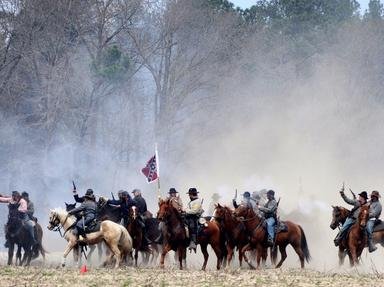Quiz Answer Key and Fun Facts
1. This battle which occurred June 10, 1861 found a force of about 3,700 to 4,400 Union soldiers being defeated by about 1,400 Confederates. General Benjamin Butler had dispatched the Union troops, under the direct command of General Ebenezer Pierce, to deal with the Confederates under the command of the then Colonel John B. Magruder, figuring the numbers would ensure a Union victory. But the result was a Confederate victory which saw the Union suffering 53 wounded, 18 KIA, and 5 MIA while the Confederacy only suffered 7 wounded and 1 KIA. What was the battle?
2. What was the supposed sign that was to be used by Union Forces at Big Bethel?
3. Butler's year didn't end with the failure of the detachment he sent to capture Big Bethel. He'd see a minor victory later in the year when his forces captured Fort Hatteras and Fort Clark in the Battle of Hatteras Inlet. What was the significance of this battle?
4. If one visits the Cape Hatteras Lighthouse, one can see where shells struck the tower and forced the federal government to make repairs to it immediately after the war.
5. This battle, which saw the death of senator turned soldier Edward Baker, had a great affect on the Union's war effort. Fought on October 21, 1861, Colonel Nathan Evans' troops defeated the Union force and cause some to jump from the cliff in an attempt to escape. What was the battle?
6. What state had Colonel Baker been a senator of immediately before the start of the war?
7. Ball's Bluff had an effect on the Union war effort. What exactly was that effect?
8. This very minor naval engagement occurred on June 26-27 1863 and involved the capture of the ship Caleb Cushing by Lt. Charles W. Read and his men. After a bit of a chase, Read and his men were be captured and the Caleb Cushing destroyed. In the coastal waters of what state did this battle take place?
9. The events leading up to this one began in January 1861, at about the time Florida seceded, when Union forces garrisoned Fort Pickens. This battle was be the first of three in the fall of 1861 to take place in the Pensacola area, occurring on the night of October 9th. After midnight, Brigadier General Richard Anderson lead a force of 1,200 Confederate soldiers into this battle in the hopes of defeating Colonel Harvey Brown's command. What was the battle?
10. This battle is generally considered the last Confederate victory of the war. Insignificant in the overall context of war effort, it would gain notoriety due to the fact that it actually took place over a month after Lee had surrendered. Colonel Theodore Barrett was in over all command of the Union forces during this May 12-13, 1865 Texas battle that included detachments from the 62nd USCT and the 2nd Texas Cavalry. What was the battle?
11. This battle from July 1863 was one of many designed to capture the city of Charleston. In June of that year Major General Quincy Gilmore had taken command of the Union forces, determining that the capture or destruction of Fort Sumter would be the key to Charleston. In order to accomplish that task, Gilmore's forces first had to capture this fort/battery from which the battle takes it's name. On the night of July 18th, Union army forces launched their attack against the fort/battery, spearheaded by the 54th Massachusetts. What was the battle?
12. Who commanded the 54th Massachusetts at the start of the Battle of Fort Wagner on July 18, 1863?
13. The July 18, 1863 Battle of Fort Wagner was actually the second Battle of Fort Wagner.
14. This battle occurred a day before the better known Battle of Gettysburg began, but it's consequences were felt at Gettysburg. A calvary battle fought between Confederate Major General JEB Stuart's cavalry command and that of Union Major General Judson Kilpatrick, the results were largely inconclusive for either side. However, this battle helped delay Stuart from joining Lee at Gettysburg until about the evening of July 2nd. What was this battle?
15. The Battle of Fort Stevens, occurring July 11-12, 1864, was a Union victory. Yet it could have possibly altered the course of the war in the Confederacy's favor with the death of a single person's life, which would have been a major coup for Lieutenant General Jubal Early as he was leading the Confederate forces in the battle. It is possible this person's life was saved by Oliver Wendell Holmes Jr shouting at him "Get down, you fool!" Who was this important person who was nearly killed at the Battle of Fort Stevens?
Source: Author
F6FHellcat
This quiz was reviewed by FunTrivia editor
bloomsby before going online.
Any errors found in FunTrivia content are routinely corrected through our feedback system.

